Discussion
Have you considered having Rover Guage permanently connected so that when the fault does eventually surface you hopefully have some parameters to guide you. A bit of a bind having a laptop connected but perhaps it may point to the culprit.
If you have not sorted the fault by September I will be at Loton Park Hill climb and you could try my 500 ECU.
If you have not sorted the fault by September I will be at Loton Park Hill climb and you could try my 500 ECU.
I have Rover gauge but don't really know what to do with it, can I record while on a run to see the difference between good and bad periods or do I need to monitor the screen continuously?
I may well come and see you at Loton, its close enough to me that I can hear the cars while in my garden, but I don't think you would be able to lend me the ecu for long enough to test fully due to the inconsistency, but thanks for the offer
Paul
I may well come and see you at Loton, its close enough to me that I can hear the cars while in my garden, but I don't think you would be able to lend me the ecu for long enough to test fully due to the inconsistency, but thanks for the offer
Paul
This is one of the reasons I've recently decided to do a megasquirt conversion as I've never been happy with all the small glitches that happen, and the rubbish quality of spare ignition components.
Not much help I know but when I ripped out the old 14 cux loom it's an eye opener how many splices etc are buried deep inside it.
Not much help I know but when I ripped out the old 14 cux loom it's an eye opener how many splices etc are buried deep inside it.
Belle427 said:
.........Not much help I know but when I ripped out the old 14 cux loom it's an eye opener how many splices etc are buried deep inside it.
I've ripped my loom apart and as you say there are splices but nowhere near (by a long way) as many as you will find in a BMW loom.Steve
I have had lamps connected to the fuel pump and coil but didn’t see any issues , I had them taped to the top of the steering column for easy visibility , I was going to connect to the injectors but it’s not so easy to access, I was about to try a couple of weeks ago but couldn’t confirm the pin layout before I needed to drive again , unfortunately my cable colours don’t seem to match the standard, but I will probably do that as well as test the RR ecu
for curiosity what is it about an aftermarket system that makes the improvement, the control itself or the replacement of cables and other components?, i must admit that i can see my loom has had some damage and repairs over the years and i was wondering about whether it can just be replaced?
Paul
Paul
I have been running on the replacement LR ECU for a few weeks but only short journeys and all ok, however, yesterday i went out for a 100 mile run, it started ok for maybe 20 miles, then i had the normal rough running, followed by a few hiccups, followed by a complete cut out, i did the normal reset of the immobiliser and carried on, by the time i had reached 40 miles a more severe misfire occured to the extent that i could not carry on because of severe shunting, so i pulled over and refitted my original ECU and just laid it on the carpet, the other had been beside the battery, it took a little while to start, only fired after putting the accelerator to the floor, i continued my journey, stopped for lunch and then drove back in which time it ran perfectly.
So to me it still looks like a overheat problem, but i cant believe the second ECU has exactly the same issue, any ideas ?????
For Rover Gauge, can i hook it up and record, or do i need to take screenshots when running good and bad ??
Paul
So to me it still looks like a overheat problem, but i cant believe the second ECU has exactly the same issue, any ideas ?????
For Rover Gauge, can i hook it up and record, or do i need to take screenshots when running good and bad ??
Paul
Steve_D said:
Belle427 said:
Best of luck with it anyway.
I do believe the switch to aftermarket management is the single best thing to do to our cars for reliability, and peace of mind.
Yes & no.I do believe the switch to aftermarket management is the single best thing to do to our cars for reliability, and peace of mind.
Only if it is done to a high standard.
COG has found his to be not so.
Steve
I burn a fuel that is notoriously hard to manage and equally hard to ignite which puts intense additional strain on the whole ignition system, many components of which such as HT leads already suffer a hard enough life in the torturously hot engine bay environment on a completely standard TVR. Like all the other aftermarket ECUs my system runs 8 saturated petrol injectors which is easy work I can tell you, heat being the enemy of all electronics this really isn't an issue with saturated petrol injectors as the heat goes to the injector not the ECU, so the fuel flowing through a petrol injector literally acts as a very effective coolant.
However, in my ECU in addition to the 8 saturated injector drivers there are 8 peak and hold injector drivers so 16 in total all inside one ECU thats no bigger than the 14CUX, plus the ignition drivers and all the other electronics of course. Now unlike those fuel cooled saturated petrol injectors, peak and hold LPG injectors put the heat to their drivers and obviously they live inside the ECU enclosure, injector resistance is critical as is how (and how well) the ECU sinks all this heat. Choose 1.2 Ohm Keihin LPG injectors instead of the industry standard 1.9 Ohm and you'll create more heat than the drivers can cope with so this should be avoided, in my ECU ceramic heat pads transfer heat to a big aluminum mounting plate which acts as a giant heat sink, so if you're building a replacement ECU for a customer you wouldn't want to forget to fit these vital ceramic heat pads now would you.
Of course all that lot must live down the passenger footwell behind the battery where there is no airflow making the heat dissipation job 10x harder. As you can see the above is far from the norm, you can hardly compare it to fitting an aftermarket petrol only system which I can tell you is a walk in the park compared with my project. Saying that I know many who've gone with a petrol only after market ECU and have ended up ripping it all out, so the fact I'm still out there day after day after day running that same foundation system I started out with some 7 years ago should tell you it's delivering the goods and its here to stay.
With the 14CUX you get a quality OEM engine management system but it's very old technology and rather difficult to work with, it also only controls the fuel and a few other elements such as the idle air control valve (stepper motor type) and its going to be a 20ish year old box of electronics thats spent its entire life down the footwell shoved in a gap between some fiberglass bodywork and the battery with heater pipes and potential leaks from the elements above it not to mention all the engine and transmission heat soak down there.
Any car engine bay is a super hostile environment for electronics, heat and especially electrical noise are your challenges. A TVR is even hotter and even noisier electrically than most so this must be understood when considering any after market engine management system installation, ask yourself how many TVRs have good radio reception and then think about why this is. Consider the importance of robust EMI shielding and good grounding.... never ever fit an after market engine management system where there are issues such as these:
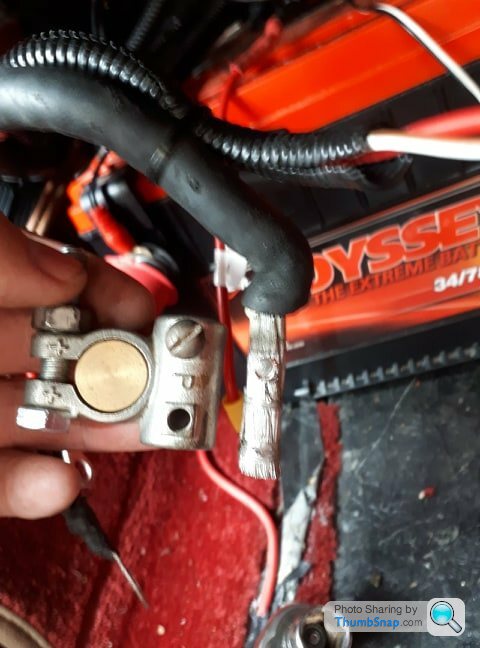
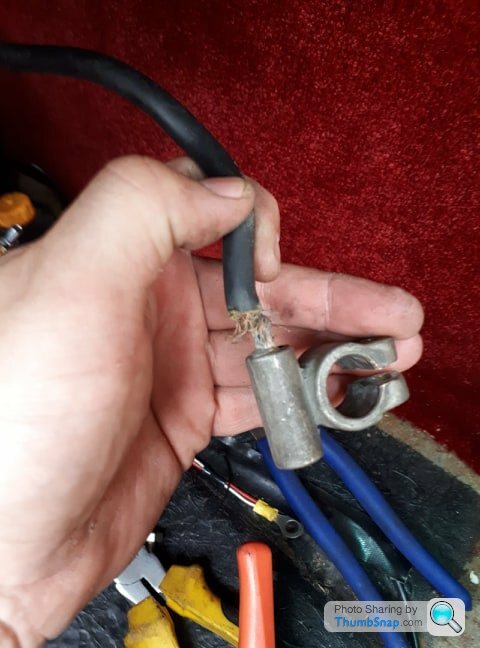
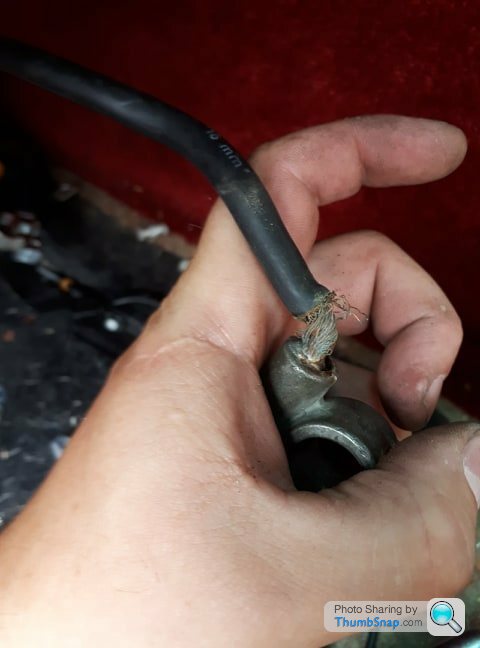
Just a few examples of a host of elements that should never be left unchecked and allowed to exist when fitting an engine management system, and avoid poor quality components like these nasty waterproof fuse holders too as they are a breakdown (or worse) just waiting to happen.
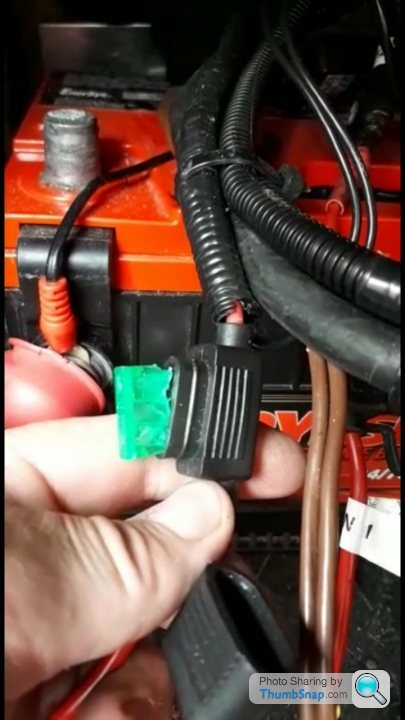
Ground loops are another consideration, avoid errors such as grounding the illuminated element of a map change switch on the same ground circuit that switches the ECU from map one to map two or you could end up with a looping priming pulse situation, which is a clear safety issue that should be taken very seriously indeed. Other areas of consideration like radiator fan switching need careful consideration as the ECU may not be capable of running two relays without one of them suffering chattering contacts and so multiple relay failures. Do install with care and don't pinch injector wires for example, and finally watch those HT leads too especially when a failed HT lead can drag down a coil pack or two.
As you can see there's a lot to consider and a lot that can go wrong, keep in mind all aftermarket ECUs are a splice job but always remember the 14CUX is very much a splice wiring job itself.... its was just one done by TVR and probably over 20 years ago now too. I've developed, developed, developed, pushing the system to and then beyond it's limits to find the weaknesses so they can be designed out and ultimately completely eradicated, this is the only way to deliver a system that can be trusted with truly robust OEM levels of reliability. At the same time I took the opportunity to make life even harder for myself by experimenting with ever better and more modern LPG components that in theory have the potential to make the system even better still, indeed the Magic Jet 3 vaporiser and LPG Tech Yeti injectors I fitted over the last 12 months of development work have proved themselves to be excellent upgrades.
I've corrected the mistakes of others and I've achieved better results in doing so, these things can end up like anything else in life.. ie you're often better doing it yourself. I also have incredibly high standards for drivability, fuel economy, performance and of course the critical element of reliability. Revealingly I've covered more miles on my Canems system than the car covered from new on the Lucas 14CUX, I've toured the European continent so many times I've lost count often traveling through 8 different countries in one trip covering more miles in a day than many TVR owners cover in an entire year in their Chimaera. I've then repeated this behavior day after day after day consecutively over weeks of driving, including crossing the Swiss & French Alps many times at altitudes of 2,800 meters above sea level followed by hours sat idling stuck in 100c ambient temp traffic jams in Italy an the South of France..
Today was just another day in the life of my TVR where 136 miles were covered, 140 leptons was seen on my sat nav, engine speed regularly went over 6k and at a steady 80mph the car was delivering the petrol cost equivalent of 50mpg. No other classic sports car is doing that, indeed no modern sports car can match that pace while serving up 50mpg fuel economy too. As the Romans taught us "Fortes Fortuna Iuvat" (fortune favors the brave), I'm very pleased all those years ago I left the 14CUX behind and even more pleased I was brave enough to choose a different path....
Exceptional results demand an innovative approach.

Edited by ChimpOnGas on Monday 24th June 09:42
So back on my original ECU, still thinking about heat so i fixed it with velcro to the battery box and didnt enclose it, took it for a 60 mile trip yesterday and by 40 miles it played up in various ways several times, pulled over and laid it on the floor, the rest of the journey and the same trip back and it ran perfectly.
took it for a little drive today to warm it up and started exploring the cables etc near the ecu, at one point the engine started running badly, play again with the cables but i cant stop it, opened the bonnet and measured on the outside of the precat area and measured 270 drivers side, 170 passengers side, after a few minutes it started working again as it always does, tried messing with the cables again but i could not repeat the fault.
So what can one cool manifold mean, no spark but as far as i know these are common apart from the HT leads to all cylinders.
Fuel pressure i believe is common to both sides.
Injectors are switched per side, so maybe not working or permanently open ??, i believe the 12V is common but obviously splits somewhere, so maybe a fault after the split, is there any reasonably easy way to run another cable and join somewhere?
the ground goes back through the ECU, i guess a break or a short here would cause the problem, again, is there an easy way to run another cable for testing?
Can RG show me something if i work out how to use it?, i do have the software and cable??
Any other thoughts??, my wife is suggesting i should consider buying a more reliable vehicle, obviously i said no to this, its very frustrating because i know its going to be a stupid little thing when i eventually find it
took it for a little drive today to warm it up and started exploring the cables etc near the ecu, at one point the engine started running badly, play again with the cables but i cant stop it, opened the bonnet and measured on the outside of the precat area and measured 270 drivers side, 170 passengers side, after a few minutes it started working again as it always does, tried messing with the cables again but i could not repeat the fault.
So what can one cool manifold mean, no spark but as far as i know these are common apart from the HT leads to all cylinders.
Fuel pressure i believe is common to both sides.
Injectors are switched per side, so maybe not working or permanently open ??, i believe the 12V is common but obviously splits somewhere, so maybe a fault after the split, is there any reasonably easy way to run another cable and join somewhere?
the ground goes back through the ECU, i guess a break or a short here would cause the problem, again, is there an easy way to run another cable for testing?
Can RG show me something if i work out how to use it?, i do have the software and cable??
Any other thoughts??, my wife is suggesting i should consider buying a more reliable vehicle, obviously i said no to this, its very frustrating because i know its going to be a stupid little thing when i eventually find it
Paul,
As the fault has appeared with both ECU's I would rule out it being an ECU fault. The fact that the fault clears when you lay down the ECU on the floor would suggest as has been suggested an intermittent break or connection in the loom to the ECU. As you have spent so much time in trying to identify the problem if it was my car I would strip back the ECU cable as far as you can go. With the wires not bound it would be much easier to wiggle individual wires.
It does sound very much as if one bank of cylinders is dropping out. ECU Pin 11 left hand bank ( yellow/white) , ECU pin 13 Right hand bank (yellow/blue)
The wire colours may be different.
IMHO I would not have thought that the temperature on the floor of the passenger compartment would be that much different to the ECU's position higher up, and as the fault occurs with both ECU's I doubt if the problem is temperature related.
Best of luck!
As the fault has appeared with both ECU's I would rule out it being an ECU fault. The fact that the fault clears when you lay down the ECU on the floor would suggest as has been suggested an intermittent break or connection in the loom to the ECU. As you have spent so much time in trying to identify the problem if it was my car I would strip back the ECU cable as far as you can go. With the wires not bound it would be much easier to wiggle individual wires.
It does sound very much as if one bank of cylinders is dropping out. ECU Pin 11 left hand bank ( yellow/white) , ECU pin 13 Right hand bank (yellow/blue)
The wire colours may be different.
IMHO I would not have thought that the temperature on the floor of the passenger compartment would be that much different to the ECU's position higher up, and as the fault occurs with both ECU's I doubt if the problem is temperature related.
Best of luck!
You will find the splices in the engine loom section next to the injectors, it may be worth you breaking into it to connect up a test lamp to monitor the 12 volt feed.
A picture of my loom below, this is the passenger side. Brown/orange is the 12 volt feed to both banks from the main relay, and yellow blue is the negative trigger. The drivers side side negative trigger is yellow/white on my car.
You need to try and narrow it down but it does sound injector related.
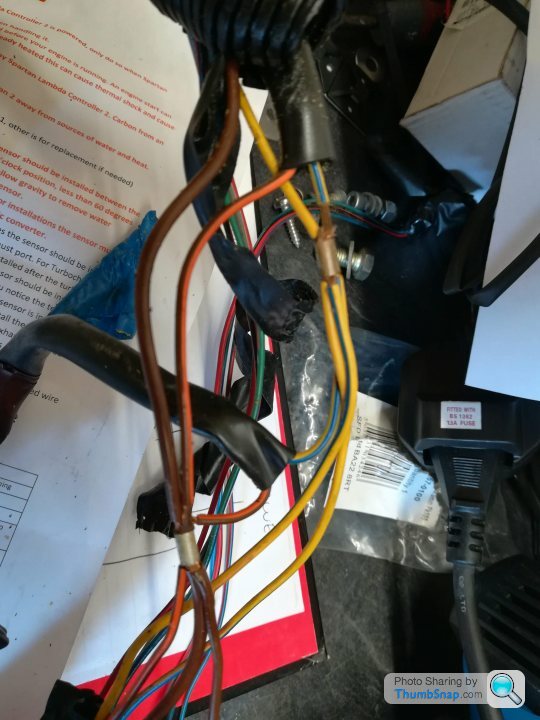
A picture of my loom below, this is the passenger side. Brown/orange is the 12 volt feed to both banks from the main relay, and yellow blue is the negative trigger. The drivers side side negative trigger is yellow/white on my car.
You need to try and narrow it down but it does sound injector related.

I found the loom with injector wiring, but not exactly easy access as it’s below the plenum, so I gained access to the wiring in the tunnel as far as possible and everything looks very good, started the engine and pushed, pulled, twisted and swung around as much as possible but to no effect, now confused, I was certain it had to be the ecu or cabling close to it, only thing I can think of now is to make a breakout lead into the injector connector to confirm that they are on continuous or off when I get the misfire 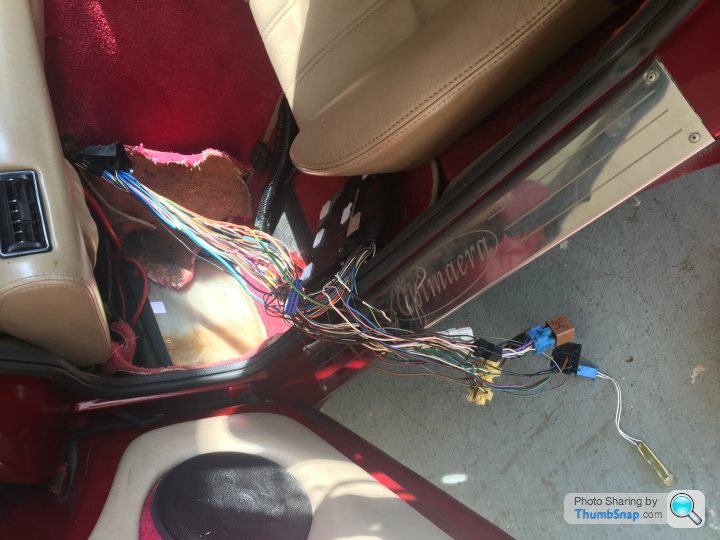

Steve_D said:
Pin numbering goes along one side then back up the middle row then down the last row.
Properly known as “boustrophedonic” motion. Possibly the bestest word in the English language.It’s from Greek.
Bous = cow, ox
Stroph = turn
Don = a suffix indicating “in the manner of”
Hence boustrophedonic means “in the manner of an ox turning”. It’s how you plough a field using oxen - you go along until you reach the end of the field, then you turn around and come back again.
Best word ever!

Gassing Station | Chimaera | Top of Page | What's New | My Stuff



